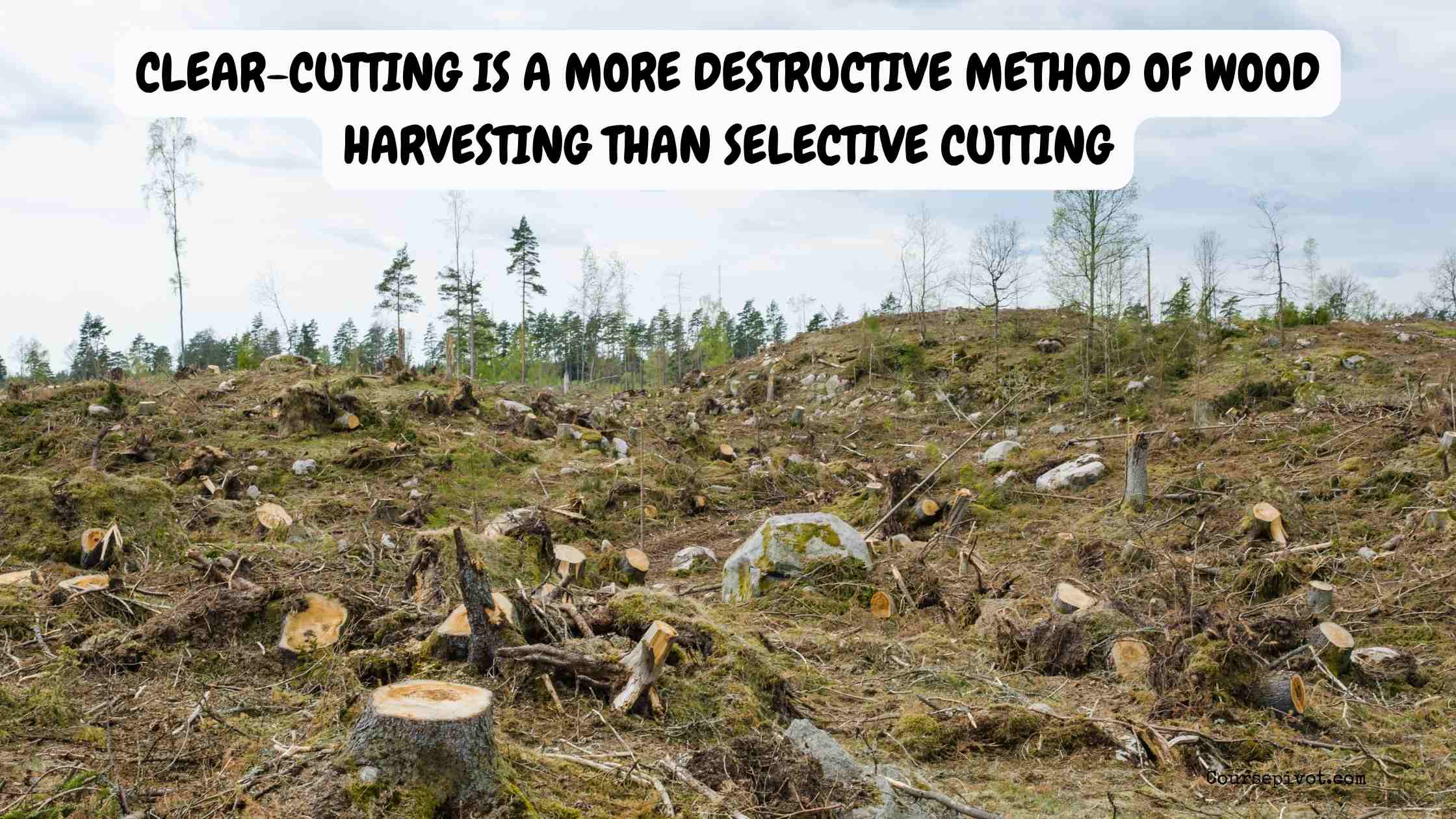
Why Clear-Cutting Is More Destructive Than Selective Cutting
Have you ever walked through a forest and felt its vibrant life, only to imagine it all gone? I’ve seen images of clear-cut landscapes, stark and barren, and it hit me how devastating wood harvesting can be. Clear-cutting and selective cutting are two methods of harvesting timber, but clear-cutting is far more destructive to ecosystems. In this blog, I’ll explain why clear-cutting is a more destructive method of wood harvesting than selective cutting, highlighting their differences and impacts.
Table of Contents
Clear-cutting removes all trees in an area, while selective cutting targets specific trees, leaving the forest intact. The choice of method shapes forests, wildlife, and even climate for generations. Why does this matter? Because forests are vital for biodiversity, carbon storage, and human well-being, and destructive practices threaten them.
I’ve always loved hiking in lush forests, and learning about clear-cutting’s toll made me value sustainable practices more. Let’s explore how these methods compare and why clear-cutting causes greater harm.
This article will define both methods, compare their environmental impacts, and explain why selective cutting is less damaging. By the end, you’ll understand the stakes of wood harvesting choices. Ready to see why clear-cutting leaves a bigger scar? Let’s dive in.
What Is Clear-Cutting?
Clear-cutting is a wood harvesting method where all trees in a designated area are cut down, regardless of size, species, or age. The result is a cleared landscape, often replanted with a single species for future harvests. It’s used for its efficiency and cost-effectiveness, maximizing timber yield in one go.
I’ve seen clear-cut areas that look like wastelands, with stumps and bare soil replacing vibrant forests. It’s a stark contrast to natural woodlands.
What Is Selective Cutting?
Selective cutting involves removing only specific trees from a forest, based on criteria like age, size, or species. The goal is to maintain the forest’s structure and ecosystem while harvesting timber. It mimics natural processes, like tree falls, and allows the forest to regenerate naturally.
I find selective cutting appealing because it preserves the forest’s beauty and function, letting you still feel immersed in nature after harvesting.
Why Clear-Cutting Is More Destructive
Clear-cutting’s widespread removal of trees causes far greater environmental harm than selective cutting. Below, I’ll break down the key reasons, comparing their impacts on ecosystems, soil, biodiversity, and climate.
Ecosystem Disruption
Clear-cutting devastates entire ecosystems, while selective cutting minimizes disruption:
- Clear-Cutting: Removes all trees, destroying habitats for birds, mammals, and insects. It disrupts food chains and can lead to species loss. Regrowth, often with monocultures, lacks the diversity of natural forests.
- Selective Cutting: Targets specific trees, preserving canopy cover and habitat continuity. Wildlife can still thrive, and the forest retains its ecological balance.
I’ve read about birds losing nesting sites after clear-cuts, forcing them to abandon areas. Selective cutting, by contrast, keeps forests habitable.
Soil Degradation and Erosion
Clear-cutting severely impacts soil health, unlike selective cutting’s gentler approach:
- Clear-Cutting: Exposes soil to sun, wind, and rain, leading to erosion and nutrient loss. Heavy machinery compacts soil, reducing fertility. Runoff from bare land pollutes nearby water bodies.
- Selective Cutting: Leaves most trees and vegetation intact, protecting soil with roots and shade. Minimal machinery use reduces compaction, and erosion is limited.
I’ve seen muddy streams near clear-cut sites, a sign of soil washing away. Selective cutting keeps soil stable, supporting future growth.
Biodiversity Loss
Clear-cutting drastically reduces biodiversity, while selective cutting supports it:
- Clear-Cutting: Eliminates diverse tree species, plants, and wildlife habitats. Replanted monocultures lack the variety needed for healthy ecosystems, making them vulnerable to pests and diseases.
- Selective Cutting: Maintains a mix of tree species and ages, fostering diverse flora and fauna. It mimics natural forest gaps, encouraging regeneration.
I was shocked to learn that clear-cutting can wipe out rare plants and animals in a single season. Selective cutting helps preserve these species.
Carbon Storage and Climate Impact
Clear-cutting worsens climate change, while selective cutting has a lighter footprint:
- Clear-Cutting: Releases stored carbon as trees are cut and burned or decay. Bare land absorbs less carbon, and replanting takes decades to restore sequestration. Soil disturbance releases additional carbon.
- Selective Cutting: Retains most trees, preserving carbon storage. Forests continue absorbing CO2, and minimal soil disruption keeps carbon locked in.
I find it alarming that clear-cutting contributes to greenhouse gas spikes. Selective cutting aligns better with climate goals.
Water Quality and Hydrologic Cycles
Clear-cutting disrupts water systems, while selective cutting protects them:
- Clear-Cutting: Increases runoff, carrying sediment and pollutants into streams. Loss of tree cover alters water retention, causing floods or droughts.
- Selective Cutting: Maintains tree cover, stabilizing water flow and filtering pollutants. Roots prevent excessive runoff, keeping streams clear.
I’ve noticed clearer rivers in selectively cut areas near my hometown compared to murky ones near clear-cuts. Water health reflects harvesting choices.
Additional Consequences of Clear-Cutting
Beyond immediate impacts, clear-cutting has broader effects:
- Aesthetic Loss: Cleared landscapes deter tourism and recreation, unlike selectively cut forests that retain beauty.
- Economic Risks: Monocultures are prone to pests, threatening long-term timber yields. Selective cutting supports sustained harvests.
- Community Impact: Indigenous and local communities reliant on forests lose resources and cultural sites.
I’ve heard stories of communities displaced by clear-cutting’s fallout. It’s a human cost selective cutting avoids.
Benefits of Selective Cutting
Selective cutting’s lower impact offers clear advantages:
- Sustains forest ecosystems and biodiversity.
- Protects soil and water quality.
- Supports long-term timber production.
- Aligns with climate and conservation goals.
I admire how selective cutting balances human needs with nature’s health. It’s a model for sustainable resource use.
Challenges and Considerations
Clear-cutting is favored for its speed and cost, especially in high-demand markets. Selective cutting requires more planning, skilled labor, and time, which can raise costs. However, long-term environmental and economic benefits often outweigh these challenges.
I’ve seen debates about logging costs, but investing in selective cutting feels like investing in our planet’s future.
Read our blog What Led to Modern Mangrove Forest Replanting Efforts
Preserving Forests for Tomorrow: Key Takeaways
Clear-cutting is more destructive than selective cutting because it devastates ecosystems, erodes soil, reduces biodiversity, releases carbon, and disrupts water cycles. Selective cutting, by targeting specific trees, preserves forest health, supports wildlife, and aligns with sustainability. I’m struck by how our harvesting choices shape the environment for generations.
Why should you care? Because forests are vital for clean air, water, and climate stability, and destructive practices threaten them. What’s stopping you from supporting sustainable logging? Advocate for selective cutting, buy certified wood, and spread awareness. Our forests deserve it.
Summarized Answer
Clear-cutting is more destructive than selective cutting because it removes all trees, causing ecosystem disruption, soil erosion, biodiversity loss, carbon release, and water quality decline. Selective cutting targets specific trees, preserving forest structure, soil, wildlife, carbon storage, and water systems, making it a less harmful, sustainable option.
Cite this article
You can copy and paste your preferred citation format below.
Martin, L. & Arquette, E.. (2025, June 3). Why Clear-Cutting Is More Destructive Than Selective Cutting. Coursepivot.com. https://coursepivot.com/blog/why-clear-cutting-is-more-destructive-than-selective-cutting/



